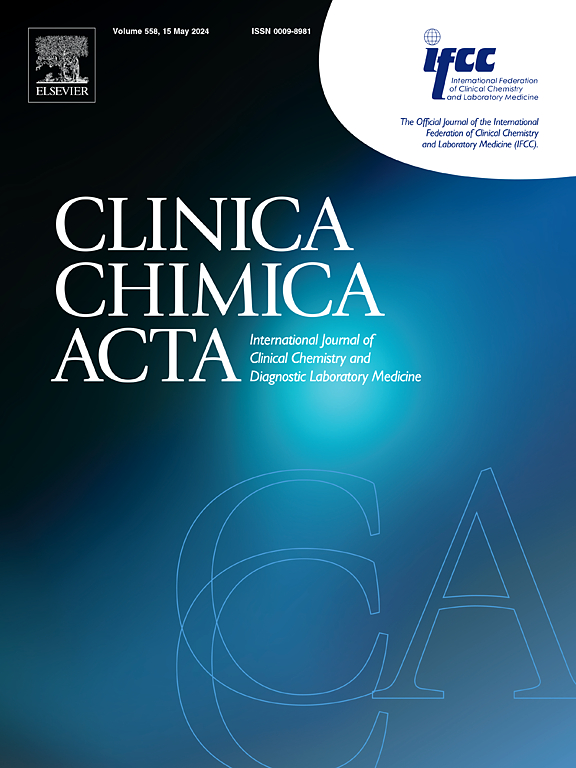尿液中MicroRNA的分离:总RNA分离试剂和二氧化硅膜提取方法的比较。
IF 3.2
3区 医学
Q2 MEDICAL LABORATORY TECHNOLOGY
引用次数: 0
摘要
背景:从尿液样本中提取microRNA (miRNA)具有挑战性,特别是对于敏感的下游分析,如定量逆转录聚合酶链反应(RT-qPCR)。虽然有商业工具包,但其高昂的成本可能使重复的实验研究望而却步。在此背景下,本研究旨在比较基于常规总RNA分离(TRI)试剂和基于二氧化硅膜的提取方法的RNA产量和纯度评分。方法:采用三种方法从尿液样本中提取miRNA: 1)二氧化硅膜法(方法1);2)基于TRI试剂(方法2);3)简易TRI试剂(方法3)。采用单因素重复测量方差分析分析RNA产率和纯度评分(A260/280和A260/230)。通过RT-qPCR对方法1和方法2的提取物进行归一化至RNU6B的hsa-miR-21-5p的相对表达量进行评估,比较基于二氧化硅膜和基于TRI试剂的效果。结果:总RNA产率(p值 = 0.005)和A260/230 (p值 260/280 (p值 = 0.177)。具体而言,与方法1 (p值 = 0.007和0.010)和方法2 (p值 = 0.046和0.009)相比,方法3的RNA产率和A260/230更高,A260/230仍在可接受范围之外。总RNA产量A260/280和A260/230在方法1和方法2之间无显著差异(p值 = 0.291,0.566和1.000)。结论:TRI试剂法在提高RNA纯度的同时,有望成为一种高效提取RNA的方法。它对研究和临床应用中的重复下游实验特别有用。本文章由计算机程序翻译,如有差异,请以英文原文为准。
MicroRNA isolation from urine: comparison of total RNA isolation (TRI) reagent and silica membrane-based extraction methods
Background
microRNA (miRNA) extraction from urine samples is challenging, especially for sensitive downstream analyses such as quantitative reverse transcription polymerase chain reaction (RT-qPCR). While commercial kits are available, their high cost can be prohibitive for repetitive experimental studies. In this context, this study aimed to compare the RNA yield and purity scores of conventional Total RNA Isolation (TRI) reagent-based to silica membrane-based extraction method.
Methods
miRNA was extracted from urine samples using three methods: 1) Silica membrane-based (Method 1); 2) TRI reagent-based (Method 2); and 3) Improvised TRI reagent-based (Method 3). RNA yield and purity score (A260/280 and A260/230) were analysed using one-way repeated measures ANOVA. The relative expression of hsa-miR-21-5p normalized to RNU6B was assessed by RT-qPCR for extracts from Method 1 and 2 to compare the effects of silica membrane-based and TRI reagent-based.
Results
Total RNA yield (p-value = 0.005) and A260/230 (p-value < 0.001) differed significantly between all methods except for the A260/280 (p-value = 0.177). Specifically, higher RNA yield and A260/230 from Method 3 were noted compared to Method 1 (p-value = 0.007 and 0.010) and Method 2 (p-value = 0.046 and 0.009), with A260/230 remaining outside the acceptable range. The total RNA yield, A260/280 and A260/230, is not significantly different between Methods 1 and 2 (p-value = 0.291, 0.566, and 1.000).
Conclusion
While the purity could be improved, TRI reagent method shows promise as an alternative for high-yield RNA extraction. It is particularly useful for repetitive downstream experiments in research and clinical applications.
求助全文
通过发布文献求助,成功后即可免费获取论文全文。
去求助
来源期刊

Clinica Chimica Acta
医学-医学实验技术
CiteScore
10.10
自引率
2.00%
发文量
1268
审稿时长
23 days
期刊介绍:
The Official Journal of the International Federation of Clinical Chemistry and Laboratory Medicine (IFCC)
Clinica Chimica Acta is a high-quality journal which publishes original Research Communications in the field of clinical chemistry and laboratory medicine, defined as the diagnostic application of chemistry, biochemistry, immunochemistry, biochemical aspects of hematology, toxicology, and molecular biology to the study of human disease in body fluids and cells.
The objective of the journal is to publish novel information leading to a better understanding of biological mechanisms of human diseases, their prevention, diagnosis, and patient management. Reports of an applied clinical character are also welcome. Papers concerned with normal metabolic processes or with constituents of normal cells or body fluids, such as reports of experimental or clinical studies in animals, are only considered when they are clearly and directly relevant to human disease. Evaluation of commercial products have a low priority for publication, unless they are novel or represent a technological breakthrough. Studies dealing with effects of drugs and natural products and studies dealing with the redox status in various diseases are not within the journal''s scope. Development and evaluation of novel analytical methodologies where applicable to diagnostic clinical chemistry and laboratory medicine, including point-of-care testing, and topics on laboratory management and informatics will also be considered. Studies focused on emerging diagnostic technologies and (big) data analysis procedures including digitalization, mobile Health, and artificial Intelligence applied to Laboratory Medicine are also of interest.
 求助内容:
求助内容: 应助结果提醒方式:
应助结果提醒方式:


